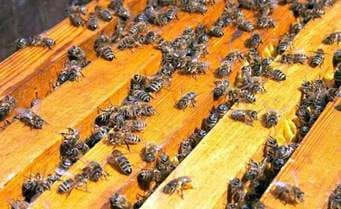
The work is carried out, during the flowering of the willow. Do it in the evening, so as not to interfere with the bees.
When the heat becomes and the upper body is filled with brood (2-3 extra honeycombs should be still free), it is necessary to warm the pavilion up to 20-25 њ C, rearrange the shells in places, and add warmed honeycomb or warm syrup honeycomb (0.5 l in each) until the housing is filled.
If in the spring in the main family an empty housing was selected, then it needs to return the second, with honeycombs suitable for laying, partially filled with honey, or with honeycombs, in which a warm syrup is poured in 0,5-1 l. The body and honeycombs must be warmed to room temperature and set in warm weather on the first case, and when it is cold under it.
On a fine day in the middle of each body it is required to put on a frame with a wax. In the upper housing, the second or third frame from the edges (on both sides) is placed along the construction frame for the drill brood, which serves to attract the mite.
If the spring is early and warm, then during the flowering of the willow to strong families that update the honeycomb, you can put 1-2 frames of the honeycomb already in early May.
The need to rearrange the buildings in places using multi-hull beehives is caused by the fact that in the spring period of its development the uterus strives to be in the warmest (upper) part of the nest and very reluctantly descends into the lower body, which bees are clogged with pago. Therefore, even in the presence of free cells there, in the upper case, too, it may lack honeycomb and reduce egg production.

The permutation of the free lower case upward makes it accessible to the uterus, which is equivalent to the expansion of the nest. The flies grow to 100 mm. In bad weather, it is necessary to continue feeding the families of protein candy and give water until the onset of stable heat.
By mid-May in multi-hive beehives with good families there should be 10-12 bee-streets and 6-8 frames of brood. By this time old bees are being replaced by young ones. If the families have 5-6 streets of bees and 3-4 frames of brood, then it is better to attach them to the middle ones, turning them into strong ones, which will increase the productivity of the apiary.
To combat the tick, it is required to fumigate bees with the addition of the aforementioned means to the smoke. Then you need to clean the pallets and again lubricate them with vaseline oil, and then put in the pallets plants and aromas that cause the shedding of the tick (Ledum, lyubovok, wormwood, thyme, turpentine, camphor oil, dill oil, etc.).
The construction of the stand with drone honeycombs can be used instead of setting up the building frames when the mite is destroyed.
If bees over the summer period have built up space in the stand with drone honeycombs, then during the first spring rearrangement of the housings, these honeycombs can not be cut. The case, the lower one, is installed with them on the spare overburden, which we place on the hull that was up above.
The drone honeycombs found in the middle of the nest are quickly mastered by the uterus, and in two weeks “tongues” are cut out together with the sealed drone brood. For this, in warm weather, in the evening, the upper hull is removed and placed sideways on the roof of the neighboring hive so that the frames in the hull assume an upright position, and the “tongues” of the honeycombs face the beekeeper.
Having finished and driven the bees from the first layer, it is necessary to cut it with a chisel, and then, alternately fumigating the layers, cut off all the “tongues” with the drone cells, clean the lower slats of the frames of the removed body and the upper slats of the frames remaining in place of the body from the excess cells tuned by the bees. Then it is necessary to remove the overburden from the lower shell and, changing the hulls in places, collect the hive. The construction of building honeycombs in this case can not be done.
According to the cut-out printed drone brood, it is easy to estimate the extent of the mite’s damage to the family. If no mites are found on 10-20 examined white pupae of drones and their cells, or no more than 4-5 mites are found on a hundred, then until the fall period, no special measures can be taken except for constant prevention.
Upon detection of more ticks in the drone brood, it is necessary to strengthen the treatment with herbal remedies, changing them more often. And in families where the fistula is removed, oxalic acid is used to destroy the tick efficiently (with the treatment of families in a no-seed state).
Pupae of drones are extracted with forceps, neatly opening the cells to a third of the height. In the course of this, not only the larvae on which the tongs are clearly visible, but also the cells from which they are taken are carefully examined. Here you need good lighting and a magnifying glass.
Turn the body sideways only if all its frames have permanent dividers, which (contrary to the opinion of some beekeepers) greatly facilitate the care of bees.
Как лучше кормить пчел. Чистка рамок.
Contents of bees in the pavilion